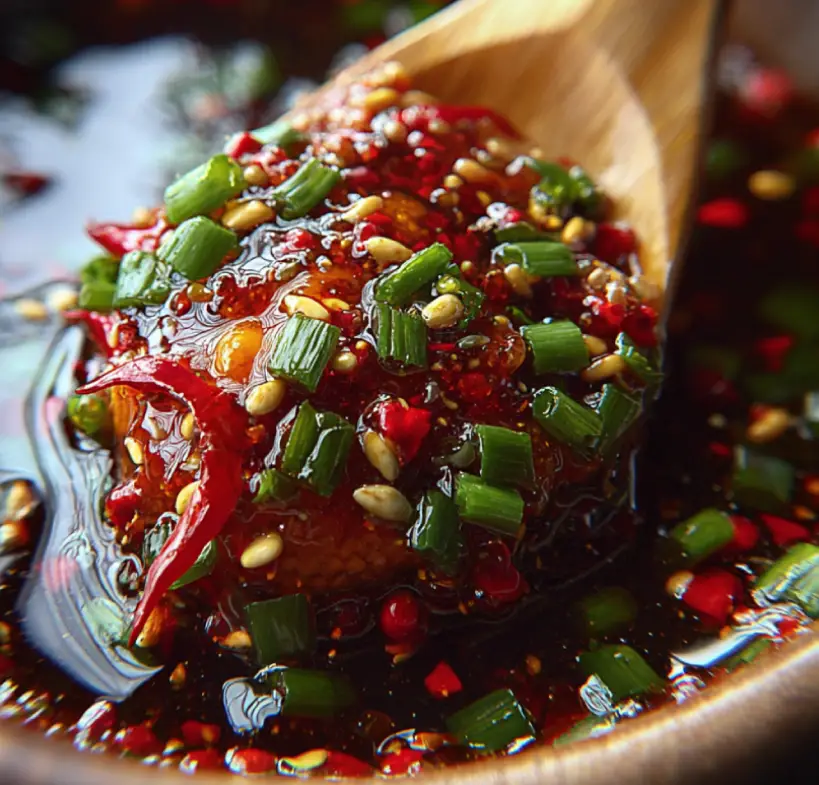Prep Time: ~10 minutes Set/Chill Time: optional about 10–15 minutes Total Time: ~10–15 minutes Yields: ~1 cup (≈250 ml)
Introduction
If you’re after a sauce that brings bold flavour, versatility and a little heat, Dragon Sauce fits the bill perfectly. Creamy and savory with a touch of sweetness and spice, it transforms simple bowls, roasted veggies or wraps into something memorable. It’s quick to make, customisable and works well in all kinds of meals — from plant-based bowls to grilled chicken or tofu.
Why Dragon Sauce Is Worth Celebrating
What makes this sauce truly special is how it balances flavour notes: nutty creaminess (from tahini or nut butter), umami depth (from soy or tamari), sweetness (maple syrup or honey) and tang (vinegar or lemon) plus a bit of heat if you like. Because you can tweak it easily and use it across meals, it becomes a go-to condiment in your kitchen for elevating everyday food.
Ingredients
- ⅓ cup tahini (or almond/cashew butter as alternative)
- 2 tablespoons soy sauce or tamari (for a gluten-free version)
- 2 tablespoons maple syrup (or honey if not vegan)
- 1 tablespoon rice vinegar or lemon juice
- 2 garlic cloves, minced
- 1 teaspoon grated fresh ginger (optional, for warmth and complexity)
- ¼-½ teaspoon chili flakes or hot sauce (adjust to taste for spice)
- Water, as needed to thin to desired consistency
- Optional: 1 tablespoon sesame oil or toasted sesame seeds for nutty finish
The Art of Creating Dragon Sauce
The key to mastering this sauce is simplicity with thoughtful balance. You combine your creamy base (tahini or nut butter) with savory soy, sweetener, acid and aromatics (garlic, ginger). Then you adjust the thickness with water and tweak spiciness to your preference. Because you focus on flavour layering and finish with a drizzleable consistency, you end up with a sauce that pours or dips easily, looks rich and tastes complex.
Step-by-Step Instructions
Step 1: Combine Base Ingredients
In a medium bowl or small blender, combine tahini, soy sauce/tamari, maple syrup, rice vinegar (or lemon juice), minced garlic and grated ginger (if using).
Professional Tip: If your tahini is very thick or resistant, allow it to sit at room temperature for a few minutes or warm slightly so it blends easily.
Key Points: A smooth base ensures the rest of the flavours integrate well.
Step 2: Add Spice and Adjust Consistency
Stir in chili flakes or a few drops of hot sauce — start with less if you’re unsure and add more later. Then gradually add water, one tablespoon at a time, until the sauce reaches your desired thickness (thicker for dip, thinner for drizzle or dressing). If using sesame oil or seeds, stir in at this point.
Professional Tip: Keep some water or lemon juice nearby so you can finely adjust the consistency right before serving.
Key Points: Thickness and spice level matter for how you’ll use it.
Step 3: Taste and Tweak
Give the sauce a taste and adjust: add more sweetener if it’s too salty/umami; more vinegar or lemon if it lacks brightness; more chili if you want heat.
Professional Tip: Let your sauce rest a couple of minutes—flavours meld and you’ll get a more accurate flavour profile for final tasting.
Key Points: Tasting and adjusting make it personal and balanced.
Step 4: Serve or Store
Use immediately as a drizzle over bowls, roasted vegetables, grilled meats, wraps or as a dip. If storing, pour into an airtight jar and refrigerate. It will keep well for up to 7 days. Before using again, stir and add a splash of water if it thickened in the fridge.
Professional Tip: Freeze in ice cube trays for single-serve portions and thaw as needed.
Key Points: Versatility and convenience enhance everyday meals.
Professional Tips for Mastery
- Use good-quality tahini or nut butter — it sets the flavour foundation.
- If you prefer a nut-free version, swap tahini for sunflower seed butter and omit sesame oil.
- For a deeper flavour, roast garlic lightly before mincing and blending.
- Adjust heat at the end — you’ll get a better gauge of overall flavour before committing to more spice.
- If you’re using this as a dressing for salad, make it a little thinner (add more water/lemon). For a dip, keep it thicker.
Creative Variations
- Thai-Inspired: Use peanut butter base, add lime juice, fish sauce, and a splash of coconut milk for a richer variation.
- Smoky Version: Add ½ teaspoon smoked paprika or chipotle powder for a smoky kick.
- Herbed Twist: Stir in finely chopped cilantro or parsley for freshness and green flavour.
- Sweet & Spicy: Add 1 tablespoon honey + 1 teaspoon sriracha for a sweet glaze effect over roasted carrots or sweet potatoes.
Perfect Pairing Ideas
This sauce pairs beautifully with grain bowls (quinoa, rice, farro), roasted veggies like broccoli or cauliflower, grilled tofu or chicken, even as a drizzle over tacos or wraps. For snacks, use as a dip for spring rolls, crudités or roasted sweet potato wedges. It also complements a chilled glass of iced green tea or sparkling water with lime.
Storage Guidelines
Store the sauce in a sealed jar in the refrigerator for up to 7 days. If it separates, simply stir and add a splash of water or lemon juice to revive consistency. For longer storage, freeze portions in ice cube trays for up to 3 months; pop cubes out and thaw in the fridge before use.
The Science Behind the Flavor
The creaminess from tahini or nut butter ensures the sauce carries fat, which helps coat ingredients and deliver flavour. Soy sauce introduces amino acids and umami, creating savoury depth. Maple syrup/ honey provide simple sugars that stimulate liking, while vinegar or lemon juice adds acid to brighten. Garlic and ginger add volatile aromatics that create complexity. Heating slightly or letting the mixture sit allows these components to meld and stabilise. The balance of fat, umami, acid, sweet and heat — the classic flavour quintet — is what makes the sauce compelling and versatile.
Troubleshooting Common Issues
- If the sauce is too thick and gloopy, add a tablespoon of water or lemon juice and stir until flowing.
- If the sauce is too runny, reduce water, or add a little more tahini or nut butter to thicken.
- If the flavour is too salty or intense, add more maple syrup or water/lemon to balance.
- If heat is overwhelming, add more base (tahini/nut butter) or sweetener, or omit extra chili next time.
Additional Inspirations
Once you’ve got the hang of Dragon Sauce, use it as the base for other dips and dressings — mix with yogurt for a creamy dressing, fold into mayonnaise or dollop it over baked potatoes with chives. You might also experiment adding roasted red pepper, miso paste or even coconut cream for global flavour variations.
Conclusion
Dragon Sauce is a flavour powerhouse that makes everyday meals feel exciting. Whether drizzled over grain bowls, used as a marinade, or served as a dip, it brings creaminess, spice, umami and versatility in one easy recipe. Celebrate that you don’t need complex technique — just thoughtful ingredients and good balance.









